
Cryphia is a genus of moths of the family Noctuidae. The genus was erected by Jacob Hübner in 1818.
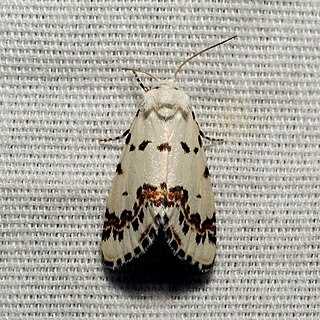
Grotella tricolor is a species of moth in the genus Grotella, of the family Noctuidae. This moth is found in the US states of California and Arizona. It was first described by William Barnes in 1904.
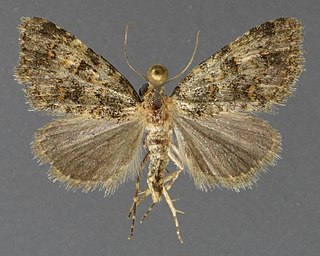
Cryphia nana is a moth of the family Noctuidae first described by William Barnes and James Halliday McDunnough in 1911. It can be found in the US state of California.
Isogona segura is a species of moth of the family Erebidae first described by William Barnes in 1907. It is found in the US state of Arizona.

Oxycnemis acuna is a moth of the family Noctuidae first described by William Barnes in 1907. It is found in North America, including Arizona and Texas.
Decaturia is a monotypic snout moth genus. Its only species, Decaturia pectinalis, is found from California to southern Arizona. Both the genus and species were described by William Barnes of Decatur, Illinois, and James Halliday McDunnough in 1912.
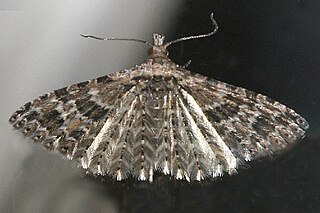
Alucita montana, the Montana six-plume moth, is a moth of the family Alucitidae. It was described by William Barnes and Arthur Ward Lindsey in 1921. It is found in North America from south-western Quebec and Vermont, west to British Columbia and south to Arizona, California and Texas.
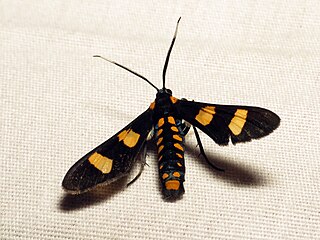
Phoenicoprocta hampsonii is a moth in the subfamily Arctiinae. It was described by William Barnes in 1904. It is found in the United States in south-eastern Arizona and in Mexico's Baja California.
Comadia intrusa is a moth in the family Cossidae first described by William Barnes and Foster Hendrickson Benjamin in 1923. It is found in North America, where it has been recorded from New Mexico, Arizona and California.
Pyrausta sartoralis is a moth in the family Crambidae. It was described by William Barnes and James Halliday McDunnough in 1914. It is found in North America, where it has been recorded from California and Arizona.
Pyrausta tuolumnalis is a moth in the family Crambidae. It was described by William Barnes and James Halliday McDunnough in 1918. It is found in North America, where it has been recorded from the western Northwest Territories and Yukon, south through British Columbia and Alberta to the mountains of California and New Mexico. The habitat consists of forested areas in the mountains.

Eudonia spaldingalis is a moth in the family Crambidae. It was described by William Barnes and James Halliday McDunnough in 1912. It is found in North America, where it has been recorded from Alberta, Arizona, British Columbia, California, Colorado, Montana, Nevada, New Mexico, Utah and Wyoming.
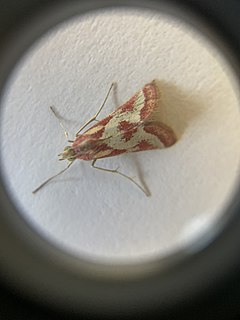
Noctueliopsis aridalis is a moth in the family Crambidae. It was described by William Barnes and Foster Hendrickson Benjamin in 1922. It is found in North America, where it has been recorded from Arizona, California and Nevada. The habitat consists of deserts.
Noctueliopsis palmalis is a moth in the family Crambidae. It was described by William Barnes and James Halliday McDunnough in 1918. It is found in North America, where it has been recorded from California, Nevada and Texas. The habitat consists of high and low elevation deserts.
Noctueliopsis virula is a moth in the family Crambidae. It was described by William Barnes and James Halliday McDunnough in 1918. It is found in North America, where it has been recorded from Arizona, California and Nevada.
Loxostegopsis merrickalis, or Merrick's pyralid moth, is a moth in the family Crambidae. It was described by William Barnes and James Halliday McDunnough in 1918. It is found in North America, where it has been recorded from Alabama, California, Florida, Georgia, Illinois, Indiana, Kansas, Maine, Manitoba, Maryland, Massachusetts, Minnesota, New Hampshire, North Carolina, North Dakota, Ohio, Ontario, Pennsylvania, Quebec, South Carolina, Texas, West Virginia and Wisconsin.
Cryphia pallidioides is a species of moth in the family Noctuidae. It is found in North America.
Cryphia flavidior is a species of moth in the family Noctuidae. It was first described by William Barnes and James Halliday McDunnough in 1911 and it is found in North America.
Cryphia sarepta is a species of moth in the family Noctuidae. It was first described by William Barnes in 1907 and it is found in North America.
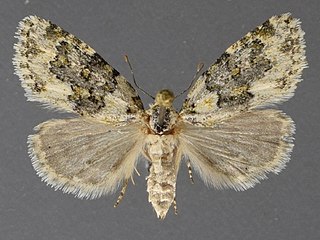
Cryphia fascia is a species of moth in the family Noctuidae.








